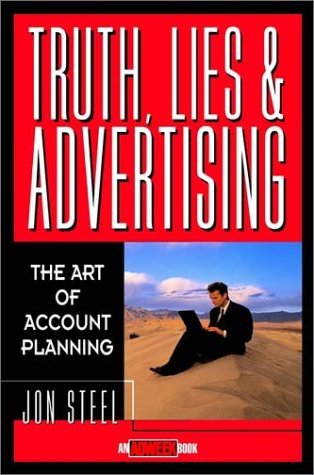 마케팅 서평 시리즈의 일환으로 최근 Jon Steel의 "진실, 거짓말, 광고: 계정 계획의 기술"을 검토했습니다. 광고에 초점을 맞추면서 이 책의 내용은 다른 마케팅 서비스 분야에도 적용 가능합니다. 특히 우리는 광고 캠페인의 시장 조사에 대한 관점을 읽고 싶어했습니다.
마케팅 서평 시리즈의 일환으로 최근 Jon Steel의 "진실, 거짓말, 광고: 계정 계획의 기술"을 검토했습니다. 광고에 초점을 맞추면서 이 책의 내용은 다른 마케팅 서비스 분야에도 적용 가능합니다. 특히 우리는 광고 캠페인의 시장 조사에 대한 관점을 읽고 싶어했습니다.
스틸의 목표는 사람의 복잡함과 감성을 바탕으로 새로운 광고 모델을 제안하는 것입니다. 이 모델은 광고 캠페인에 이해관계자의 파트너십을 통합합니다.
- 클라이언트의 비즈니스 관점
- 대행사의 창의적인 관점
- opinions and prejudices of the people at whom advertising is aimed; In other words, the consumer needs to be probed for insecurities, motivations, habits, and prejudices
이러한 관점을 "삼각측량"함으로써 진실에 더 가깝게 찾아낼 수 있습니다. 이 모델의 기본은 혼돈에 대한 감사입니다. Steel의 정당성은 전체의 합이 개별 부분보다 크다는 것입니다. 반대로, 한 가지 관점이 지배적으로 허용되면 광고 캠페인의 품질과 효과가 저하될 수 있습니다. Steel은 Chaos가 고객에게 최고의 작업을 제공하는 데 유용할 수 있다고 말합니다.
- 광고 연구에 영향을 미치는 환경
- 어떤 종류의 분위기를 조성합니까?
- 기회(권장되어야 함)
Steel은 계속해서 혼돈과 관련하여 양자 물리학과 광고 사이의 예상치 못한 유사점을 도출합니다. 결국 스틸은 양자물리학에서 대립되는 관점에 대한 혼돈과 욕망이 그의 다양한 관점에 대한 접근 방식과 유사함을 암시한다.
Steel continues to define Advertising according to Jeff Goodby’s definition: getting into one’s mind and changing one’s mind, but not telling one how to think. Along these lines, Steel asserts that Advertising cannot sell something; instead it influences the mind, which can influence purchasing.
그렇다면 광고는 예술인가, 비즈니스인가? Goodby는 광고가 마음을 바꾸는 사업이라고 말했습니다. 따라서 광고는 예술과 상업이 혼합된 형태로 상업 쪽으로 기울어져 있는 것처럼 보입니다. 광고를 대부분 예술로 생각하는 것은 고객의 이익보다 창작자의 이익을 우선시하는 문제를 제기하므로 문제가 있습니다. Steel은 광고주가 고객의 목표가 제품이나 아이디어를 판매하는 것임을 깨달아야 함을 의미합니다.
게다가 광고는 과학인가 예술인가? Steel은 광고가 인간 감정의 복잡성을 무시하기 때문에 과학이 아니라고 말합니다. 과학에서는 Margaret Wheatley의 기계 모델에 따라 구성 요소를 분해하고 물건을 재구성할 수 있다고 가정합니다. Steel에 따르면 지나치게 과학적인 데이터는 나무에만 집중하고 숲을 무시할 수 있다고 합니다.
Steel writes about the power of the unscientific method. He cites evidence that some of the best brains, including Einstein, Oppenheimer (a physicist), and Watson/Crick, deviated from the scientific method by combining science and art (intuition, fantasy). Steel implies that this occurred because these great thinkers realized that the scientific method could not explain everything.
맥락상 광고는 소비자에게 다가가는 데 몇 가지 문제에 직면합니다. 광고는 사람들을 대상으로 하며 그들에게 무엇을 해야 할지 말하려고 합니다. 메시지가 과도하게 사용되었습니다. 결과적으로 사람들은 광고를 싫어합니다. Steel은 광고의 삼위일체는 다음과 같이 구성되어 있다고 제안합니다.
- 간단
- 상식
- 창의성
연구에 대한 아이디어
Steel asserts that clients assume that those on the outside share their same amount of knowledge, and that it was the role of the planner needs to change this. He indicates that the focus group moderator should have the power to introduce a completely new idea and deviate from the discussion guide. For example, he worked on a project on “Disability Insurance,” which by itself is a word that makes people shudder. Exploratory research was employed to allow the respondent to freely think and speak her thoughts. He found that respondents considered disability insurance as a necessary evil. As a result, the resulting ad campaign focused on the wide picture of the future and the realities that would impact some of the population. The message was that the company had your interests at heart.
Steel also claims that researchers need to look at what is not being said. Citing the example of a project for KPMG Peat Marwick, he had conducted many interviews with high-level executives. All research interviews consisted of the respondent telling the interviewer that what they were saying was all confidential. Hence, he came up with the idea to make a slogan conveying the exciting, stealthy, and confidential nature of what KPMG did.
결국 이 책에는 창의적인 광고의 생생한 사례가 담겨 있습니다. 읽기 쉬운 문체는 광고의 단순성과 상식에 대한 그의 전반적인 이론과 일치합니다. 광고 캠페인에 대한 이론은 가장 효과적인 광고 캠페인을 개념화하는 데 도움이 됩니다. 우리의 유일한 불만은 연구에 대한 아이디어가 "Culture Code"의 저자인 Clotaire Rapaille와 같은 장르의 다른 작가들로부터 많은 가치를 추가하지 못했다는 것입니다.



